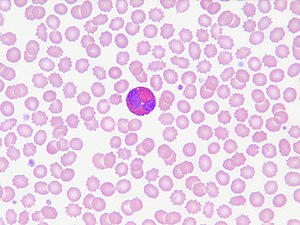Pulmonary eosinophilia
| Eosinophilia | |
|---|---|
 |
|
| Eosinophils in the peripheral blood of a patient with idiopathic eosinophilia | |
| Classification and external resources | |
| Specialty | Infectious disease |
| ICD-10 | D72.1 |
| ICD-9-CM | 288.3 |
| DiseasesDB | 4328 |
| eMedicine | med/685 |
| Patient UK | Eosinophilia |
| MeSH | D004802 |
Eosinophilia is a condition in which the eosinophil count in the peripheral blood exceeds 4.5×108/L (450/µL). Eosinophils usually account for less than 7% of the circulating leukocytes. A marked increase in non-blood tissue eosinophil count noticed upon histopathologic examination is diagnostic for tissue eosinophilia. Several causes are known, with the most common being some form of allergic reaction or parasitic infection. Diagnosis of eosinophilia is via a complete blood count (CBC), but diagnostic procedures directed at the underlying cause vary depending on the suspected condition(s). An absolute eosinophil count is not generally needed if the CBC shows marked eosinophilia. The location of the causal factor can be used to classify eosinophilia into two general types: extrinsic, in which the factor lies outside of the eosinophil cell lineage; and intrinsic eosinophilia, which denotes etiologies within the eosiniphil cell line. Specific treatments are dictated by the causative condition, though in idiopathic eosinophilia, the disease may be controlled with corticosteroids. Eosinophilia is not a disorder (rather, only a sign) unless it is idiopathic.
Eosinophilia can be idiopathic (primary) or, more commonly, secondary to another disease. In the Western World, allergic or atopic diseases are the most common causes, especially those of the respiratory or integumentary systems. In the developing world, parasites are the most common cause. A parasitic infection of nearly any bodily tissue can cause eosinophilia. Diseases that feature eosinophilia as a sign include:
Hodgkin lymphoma (Hodgkin's disease) often elicits severe eosinophilia; however, non-Hodgkin lymphoma and leukemia produce less marked eosinophilia. Of solid tumor neoplasms, ovarian cancer is most likely to provoke eosinophilia, though any other cancer can cause the condition. Solid epithelial cell tumors have been shown to cause both tissue and blood eosinophilia, with some reports indicating that this may be mediated by interleukin production by tumor cells, especially IL-5 or IL-3. This has also been shown to occur in Hodgkin lymphoma, in the form of IL-5 secreted by Reed-Sternberg cells. In primary cutaneous T cell lymphoma, blood and dermal eosinophilia are often seen. Lymphoma cells have also been shown to produce IL-5 in these disorders. Other types of lymphoid malignancies have been associated with eosinophilia, as in lymphoblastic leukemia with a translocation between chromosomes 5 and 14 or alterations in the genes which encode platelet-derived growth factor receptors alpha or beta. Patients displaying eosinophilia overexpress a gene encoding an eosinophil hematopoietin. A translocation between chromosomes 5 and 14 in patients with acute B lymphocytic leukemia resulted in the juxtaposition of the IL-3 gene and the immunoglobulin heavy-chain gene, causing overproduction production of IL-3, leading to blood and tissue eosinophilia.
...
Wikipedia
